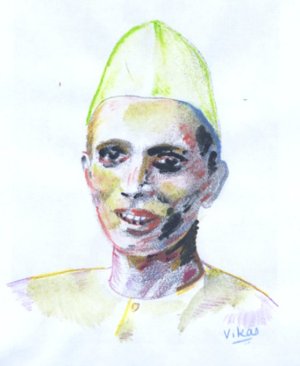Karnad Sadashiva Rao
by Jyotsna Kamat
First Online: August 15, 2003
Page Last Updated: December 07, 2024
An affluent neighborhood in the city of Bangalore is known as Sadashivanagar today. Very few people know that it is named after Karnad Sadashiva Rao, a glorious son of Karnataka who died penniless (catching a cold, and without warm clothing) in the cause of India.
Sadashiva Rao was born in a wealthy family, but spent all his material wealth in India's service. He was a social reformer, a great patriot, tireless organizer, a fatherly figure to the downtrodden, and a humanitarian. He was a Gandhian to the core. He is referred to as "Dharmaraj" (embodiment of charity) by Dr. Shivaram Karanth, the great Kannada writer, whose famous novel "Oudaryada Urulalli" is centered around a Sadashiv Rao-like hero.
© Vikas Kamat

Karnad Sadashiv Rao (1881- 1936)
Karnad Sadashiva Rao was born in 1881 in Mangalore, the only son of a rich and leading lawyer Ramachandra Rao and Radhabai. Even as as young boy, he used to give his books to poorer classmates, facing admonishing from his father, who was a strict disciplinarian. He studied at presidency college in Madras and later studied law in Bombay. He played tennis and cricket, and was a member of a elite sports club.
But Sadashiva was attracted to the Indian nationalistic movement that was sweeping the country and took to austere, simple life. With the help of his devoted wife Shantabai, he founded an organization "Mahila Sabha" for betterment of widowed and downtrodden women. He provided funds to educate them and find means of self-support. Several were trained to become teachers, nurses, and tailors.
He organized re-marriage of child-widows, fighting a big social problem at the time. He also worked for betterment of Harijans. He was a member of the organization "Mission for Depressed Classes" for years, eventually serving as its president. He fought and arranged for entry of Harijans in the temples of South Kanara district. He started a school "Tilak Vidya;aya" in the premises of his home, open to all communities. The Hindi languages, spinning, weaving, and other handicrafts were taught in the school. Eighteen such educational centers were started in the district. Sadashiv Rao stopped animal sacrifice at Kali temples.
The year 1919 saw him fully involve in India's Freedom Struggle. Gandhi had launched the first satyagraha, and Sadashiva Rao was among the first volunteer from Karnataka to take pledge to be a volunteer in the independence movement.
He was responsible for building of Congress Party in the state of Karnataka. He organized people moving from town to town, and from village to village, creating awareness of freedom and independence, and spreading the gospel of Sarvodaya. In year 1923, he lost his youngest daughter, the only son, and also his soul-mate Shantabai who had actively supported him in his multifarious activities. A shattered man, Sadashiva went to Ganhiji's Sabarmati ashram to seek solace, only to respond to distress call from his district, which faced unprecedented deluge and needed immediate relief. He organized relief camps, provided food and shelter from his personal funds. He was a front-level leader in the "No-tax" campaign and the Salt Satyagraha.
Sadashiva Rao's house was a hub of India's freedom fight. It served as a guesthouse for national leaders like C.R. Das, Sarojini Naidu, C. Rajgopalachari and others besides Mahatma Gandhi.
In a caste-torn time, Sadashiva Rao united various communities of South Kanara for the cause of freedom. He was jailed three times, and during those five years, his health deteriorated. He even refused mosquito-curtain in the prison, because it was not given to all inmates. He'd lost all his inherited assets, including his ancestral home due to his "generous to a fault" nature, and due to the treachery of some of his associates. His old mother and daughters had to live in a small rented house.
At the Faizpur Congress Session (year 1936), he was thoroughly soaked due to leakage in the hut he was staying. he caught fever and traveled to Bombay on Congress work without telling anybody about his physical condition. The fever worsened, and soon after reaching Bombay he died. He was 56.
Not long after his death, Gandhi went to see Sadashiva Rao's mother. He bowed before her and said "Blessed are you mother, for having borne a son such as he".
The Roman Catholic community of South Kanara paid the highest tributes. "Sadashiva Rao's life was Christ-like, for it depicted purity of soul, and mind, nursed by supreme sacrifices". It was evident that Christians in South Kanara had joined Congress because of self-sacrifices of Sadashiva Rao.
![]()
See Also:
- Gangadharrao Deshpande
- History of Kannada Language -- Jyotsna Kamat on the origins, development and important periods in the Kannada literature.
- Kannada Writers &Poets

